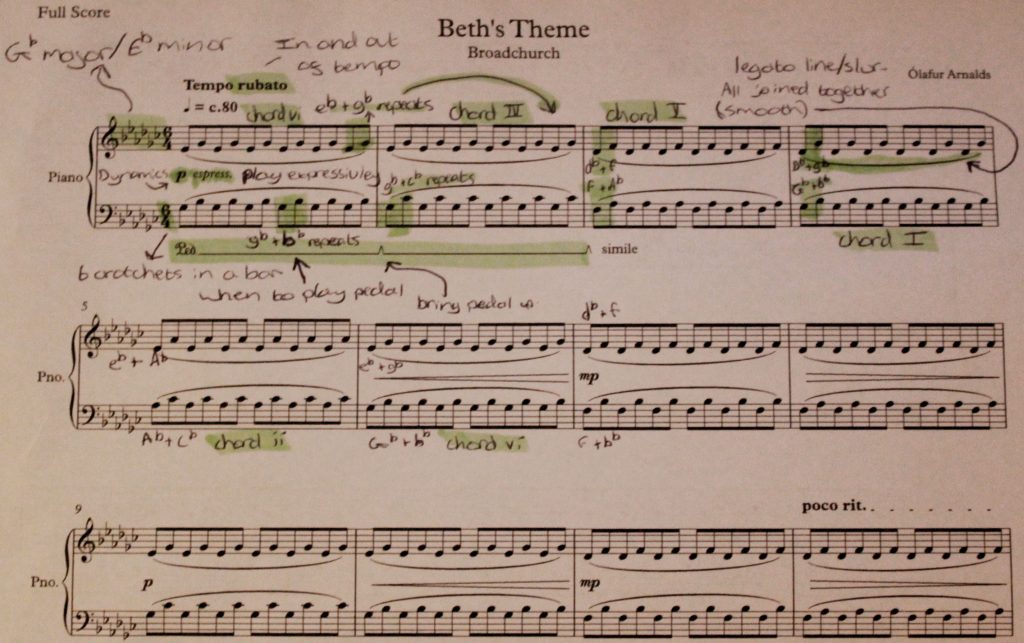Olafur Arnalds is a composer and multi-instrumentalist from Iceland. He does solo work, film and other art score and collaborates with other artists. His 5th album, released in 2020 is called ‘Some Kind Of Peace’. This composition is from the TV show Broadchurch; about two detectives trying to solve the murder of a young boy. All 3 seasons had amazing reviews for compositions, writing and character development. The song represents Beth’s character in the show. Her son was murdered and she is trying to solve his death alongside another detective. The score embodiments her mourning and feelings of loss she experiences through the whole show.
I really enjoyed this composition as the composer has definitely been successful in conveying emotions and I feel like it fits well with the background of the show and her character. I appreciate the calmness of the score, coming from the slow-sounding tempo and the fairly thin texture in most of the piece. The composition made me feel a series of saddening emotions like empty, melancholic and sorrowful, mostly because of the minor chords, and again, the slow-paced tempo. I think the composer has been successful in wanting to express these emotions and even more, perhaps conflicting feelings. For example, the middle of the song could sound somewhat triumphant because of the loud string quartet which comes in near the end of their part.
I can hear a piano and a string quartet consisting of two violins, one viola and one cello. The piano first plays first as a solo instrument, giving this part a very thin texture. Then, near the middle of the piece, the strings gradually come in and so the texture gets thicker. Strings drop out near the end of the score, leaving the piano, and therefore, the texture becomes very thin again.
When the piano is playing solo, the dynamics are about P (piano, very quiet). The string quartet and piano gradually grow to about MF (mezzo-forte, quite loud) during the middle and to F towards the end, before the strings drop out. The strings use crescendos and diminuendos in the single bars, but overall they gradually get louder. This huge dynamic range allows for many types of articulation and makes the shape of the track more complex. The articulation could be described as legato (smooth) as in the notation, many notes are tied together.
I would say the structure is in sections and not in verse, chorus structure. In particular, I can hear three different sections, two of which repeat. The A section is the soloed piano at the beginning. This same exact section is then repeated at the end, making this section C. Therefore, Section B is when the strings come in, during the middle of the song. This means the structure is A-B-C. To give the composition’s structure more emotion, the score (see picture below) says ‘express.’, meaning the player has to perform the song expressively, capturing the mood of the composition by adding their own articulation, dynamics, and other musical elements.
The key of the song is E flat minor/G flat major I can tell this because the score has six flats in its key signature. There are a lot of different chord changes from both piano and violin but the chord changes occur slowly, once every single bar, without fail. This makes the chord sequence difficult to analyse all the way through because there are so many chords to make out. However, I analysed the chords of the first eight bars of the score (see picture below). The chord structure for these six bars is vi IV V I ii vi. The cello does not play the same note as the left-hand piano so they are in harmony with each other as the cello is a third down, however, all of the harmonies stay within the key so the harmony is diatonic. Because of this, the chords the composer is playing are fairly simple.
Not many melodies occur in this composition, except for the arpeggios playing from the piano. This melody is quite hard to remember as the rhythm is very repetitive and the chord changes are slow. Other than this, it is mostly piano chords and singular held notes on the violin. I feel like a melody over the top would make the song less effective as that will be at the forefront of the piece. Without the melody, every instrument is equal and appreciated. In the score I analysed below, the piano has pedal markings, showing the pianist when to use the pedal and when to bring it up. The use of the pedal makes the composition sound more graceful. This goes well with the fact the strings have ties on the notes, making them legato as the different notes are smooth and connected.
The time signature is in 6/4 (six crotchets in a bar, the six crotchets being grouped in 2 sets of three.). The BPM of the piece is 80, meaning the tempo can be described as andante. The score is performed in rubato, meaning that the tempo is always slowing down and speeding up, but deliberately. It also has poco rit markings, meaning you have to slow down at that certain point.
I do not know much about production however, I would expect that compression has been used here as most songs have this. Compression is needed as it makes all the volumes equal by reducing the volume of loud sounds and increasing the volume of quiet sounds.
